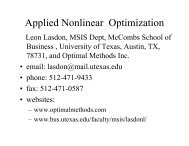[PDF] ALIO Back Matter
[PDF] ALIO Back Matter
[PDF] ALIO Back Matter
You also want an ePaper? Increase the reach of your titles
YUMPU automatically turns print PDFs into web optimized ePapers that Google loves.
SD20<br />
2 - Optimal Map Segmentation for Vehicle Routing and Other Resource<br />
Allocation Problems<br />
John Carlsson, Assistant Professor, University of Minnesota,<br />
111 Church Street SE, Department of Mechanical Engineering,<br />
Minneapolis, MN, 55455, United States of America,<br />
jgc@me.umn.edu<br />
Segmenting a given geographic region into pieces is a problem that arises in many<br />
contexts, such as congressional redistricting and vehicle routing. Here we describe<br />
several geometry-based algorithms for partitioning a region into pieces optimally<br />
when the objective is to balance the loads of vehicles in a service region.<br />
3 - Dynamic Vehicle Routing Under Congestion using<br />
Real-time ITS Information<br />
Ratna Babu Chinnam, Associate Professor, Wayne State University,<br />
4815 Fourth St., Detroit, MI, 48202, United States of America,<br />
R_Chinnam@wayne.edu, Alper Murat, Ali R. Guner<br />
Travel time delays and variability, attributable to network congestion, are impacting<br />
the efficiency of JIT logistics operations. We propose a stochastic programming<br />
algorithm for dynamic routing of vehicles in stochastic dynamic networks subject to<br />
recurrent (i.e. rush hour) and non-recurrent (i.e. incident) congestion. We also<br />
propose integration of an incident induced delay model to our algorithm. The<br />
algorithm is tested in a Michigan road network using historical data from the MITS<br />
Center.<br />
4 - Metaheuristics for the Waste Collection VRP with Time Windows<br />
and Multiple Disposal Facilities<br />
John Beasley, Brunel University, Mathematical Sciences, Uxbridge,<br />
UB8 3PH, United Kingdom, John.Beasley@brunel.ac.uk<br />
Vehicles go out from the depot and collect waste from customers, emptying<br />
themselves at the waste disposal sites as and when necessary. A nearest neighbour<br />
approach is used to obtain an initial solution. We improve this solution using an<br />
approach based on neighbour sets. Computational results are presented for problems<br />
involving up to 2100 customers using tabu search, variable neighbourhood search<br />
and variable neighbourhood tabu search.<br />
<strong>ALIO</strong> / INFORMS International – 2010<br />
48<br />
■ SD20<br />
Aula 382- Third Floor<br />
Cutting and Packing 2<br />
Cluster: 7th ESICUP Meeting<br />
Invited Session<br />
Chair: A. Miguel Gomes, Faculdade de Engenharia da Universidade do<br />
Porto, Rua Dr. Roberto Frias, s/n, Porto, 4200-465, Portugal,<br />
agomes@fe.up.pt<br />
1 - Strip Packing: What Can We Learn from Project Scheduling?<br />
Sam D. Allen, University of Nottingham, School of Computer<br />
Science and IT, Jubilee Campus, Nottingham, United Kingdom,<br />
sda@Cs.Nott.AC.UK, Sven Groenemeyer, Edmund K. Burke,<br />
Graham Kendall<br />
In this talk we re-examine the intrinsic similarities between the formulation of the<br />
higher-dimensional strip-packing problem and the resource-constrained project<br />
scheduling problem as highlighted by Hartmann in 2000. We discuss approaches to<br />
both problems and present previous results based on each problem. We will then<br />
conclude with some transformations of heuristics intended for each problem in<br />
order to tackle the alternative problem, and discuss their effectiveness in each<br />
domain.<br />
2 - Geometric Operations Involving Cutting-stock Problem Through<br />
CAD Application<br />
Cliceres Mack Dal Bianco, Universidade Federal de Santa Maria -<br />
UFSM, UFSM Prédio 07 S 305 Centro de Tecnologi, Rua Adriano<br />
Chaves 270, apto 270 - Camob, Santa Maria, 97105010, Brazil,<br />
cliceres@gmail.com, Alexandre Dias Silva<br />
Systems to solve Cutting-stock Problems involve geometric operations such as:<br />
rotation and verifications of overlapping. To eliminate the need of implementing<br />
complex algorithms, this work presents as alternative for the 2D rectangular<br />
guillotine cutting, the development of these operations the use of resources<br />
available in CAD systems. The feasibility of implementing the technique was<br />
demonstrated in AutoCAD, through the utilization of drawing functions in<br />
programs developed in AutoLISP.<br />
3 - Rect-TOPOS: A Constructive Heuristic for the Rectangle Packing<br />
Area Minimization Problem<br />
A. Miguel Gomes, Faculdade de Engenharia da Universidade do<br />
Porto, Rua Dr. Roberto Frias, s/n, Porto, 4200-465, Portugal,<br />
agomes@fe.up.pt, Marisa Oliveira, Eduarda Pinto Ferreira<br />
To solve the rectangle packing area minimization problem we propose a variant of<br />
the TOPOS algorithm. In our adaptation, the layout is build by successively adding a<br />
new rectilinear piece to a partial solution while minimizing the enclosing<br />
rectangular area. Several criteria to choose the next piece and its orientation are<br />
proposed and compared. To evaluate and compare partial solutions different<br />
objective functions were used. Supported by FCT project PTDC/GES/ 72244/2006.<br />
4 - A Tree-search Algorithm for the Two-dimensional Rectangular<br />
Strip Packing Problem<br />
José F. Oliveira, Universidade do Porto, Faculdade de Engenharia /<br />
INESC Porto, Rua Dr. Roberto Frias, Porto, Portugal, jfo@fe.up.pt,<br />
Maria Antónia Carravilla, André Carqueja<br />
In this talk a tree-search algorithm for the two-dimensional rectangular strip<br />
packing problem will be presented. This algorithm is based on a MIP model, where<br />
the binary variables stand for the relative position of the rectangles among each<br />
other. The variables are progressively fixed along the search, while bounds are<br />
produced and updated by the resolution of relaxations of the model. Computational<br />
results obtained with benchmark instances for this class of problems are presented.


![[PDF] ALIO Back Matter](https://img.yumpu.com/17932960/28/500x640/pdf-alio-back-matter.jpg)
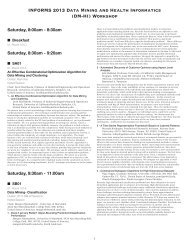
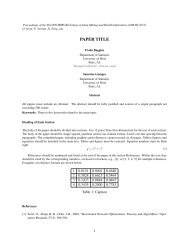
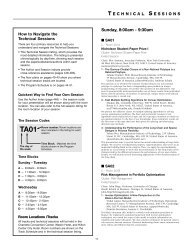
![[PDF] Charlotte Back Matter](https://img.yumpu.com/17933057/1/190x245/pdf-charlotte-back-matter.jpg?quality=85)


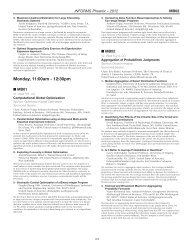

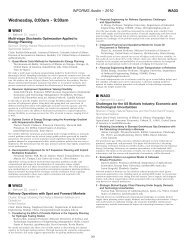
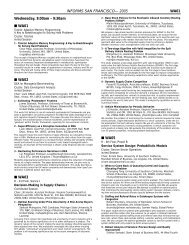
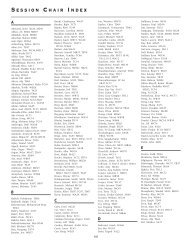
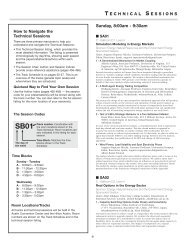
![[PDF] Monday, 8:00am - 9:30am](https://img.yumpu.com/17932954/1/190x245/pdf-monday-800am-930am.jpg?quality=85)
